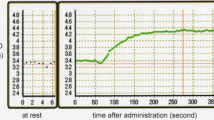Summary
Ergotamine was used to induce arterial contraction in vitro (measurement of isometric tension in segments from 3 human temporal arteries) and in vivo (peripheral systolic blood pressure measured by strain gauge plethysmography in 5 migrainous patients). In both these models of ergotism, the directly acting vasodilator nitroglycerine (NTG) effectively relieved the ergotamine-induced arterial contractions. A case of ergotism treated succesfully with NTG infusion is reported. The diagnosis was based on history and measurement of peripheral systolic blood pressure by strain gauge plethysmography. The latter technique was also used to monitor the response to treatment for 20 h. Blood levels of ergotamine during ergotism were in the therapeutic range. Possible explanations for this finding are discussed.
Similar content being viewed by others
References
Krupp P, Haas G (1979) Effets indesirables et interactions medicamenteuses des alcaloides de l'ergot de seigle. J Pharmacol (Paris) 10: 401–12
Hessov I, Kromann-Andersen C, Madsen B (1972) Peripheral arterial insufficiency during ergotamine treatment. Course of disease, angiographic findings and treatment by phenoxybenzamine. Dan Med Bull 19: 236–44
Carliner NH, Denune DP, Finch Jr CS, Goldberg LI (1974) Sodium nitroprusside treatment of ergotamine-induced peripheral ischemia. J Am Med Assoc 227: 308–9
Husum B, Metz P, Rasmussen JP (1979) Nitroglycerin infusion for ergotism. Lancet II: 794–95
Müller-Schweinitzer E (1976) Evidence for stimulation of 5-HT receptors in canine saphenous arteries by ergotamine. Naunyn-Schmiedberg's Arch Pharmacol 295: 41–44
Tfelt-Hansen P, Eickhoff JH, Olesen J (1980) The effect of single dose ergotamine tartrate on peripheral arteries in migraine patients. Methodological aspects and time effect curve. Acta Pharmacol Toxicol 47: 151–56
Østergaard JR, Voldby B (1981) Altered extracranial reactivity in patients with cerebral arterial aneurysm: An in vitro study. Surg Neurol 15: 47–50
Edlund P-O (1981) Determination of ergot alkaloids in plasma by high performance liquid chromatography and fluorescence detection. J Chromatogr 226: 107–15
Chu SY, Oliveras L, Deysai S (1980) Extraction procedure for measuring anticonvulsant drugs by liquid chromatography. Clin Chem 26: 521–22
Rothlin E, Cerletti A (1949) Untersuchungen über die Kreislaufswirkung des Ergotamins. Helv Physiol Acta 7: 333–70
Müller-Schweinitzer E, Weidman H (1977) Regional differences in the responsiveness of isolated arteries from cattle, dog and man. Agents Actions 7: 383–89
Ala-Hurula V, Myllylä VV, Arvela P, Heikkilä J, Kärki N, Hokkanen E (1979) Systemic availability of ergotamine tartrate after oral, rectal and intramuscular administration. Eur J Clin Pharmacol 15: 51–55
Wolff HG (1962) Headache and other head pain. 2nd ed. Oxford University Press, Oxford
Krabbe AAe, Olesen J (1980) Headache provocation by continuous intravenous infusion of histamine. Clinical results and receptor mechanism. Pain 8: 253–59
Merhoff GC, Porter JM (1974) Ergot intoxication: Historical review and description of unusual clinical manifestations. Ann Surg 180: 773–79
Dige-Petersen H, Lassen NA, Noer I, Tønnesen KH, Olesen J (1977) Subclinical ergotism. Lancet II: 65–66
Tfelt-Hansen P, Krabbe AÆ (1981) Ergotamine abuse. Do patients benefit from withdrawal? Cephalalgia 1: 29–32
Lavene D, Longchampt J, Guillaume MF, Kiger JL (1976) Drug interactions of the components of Optalidon after oral administration. Int J Clin Pharmacol 13: 235–45
Mayer SE, Melmore KL, Gilman AG (1980) In: Goodman LS, Gilman A (Eds) The pharmacological basis of therapeutics, 6th ed. Macmillan, New York, pp 23–24
Baumrucker JF (1973) Drug interaction-propranolol and cafergot. N Engl J Med 288: 916–17
Harrison TE (1978) Ergotaminism. J Am Coll Emergency Physicians 7: 162–69
Robinson BF, Dobbs RJ, Kelsey CR, Saverymuttu S (1981) A method for assesing responses of small arteries in man: effect of physiological and pharmacological stimuli. Clin Sci 60: 659–66
Kaplan JA, Finlayson DC, Woodwaed S (1980) Vasodilator therapy after cardiac surgery: A review of the efficacy and toxicity of nitroglycerin and nitroprusside. Can Anaesth Soc J 27: 254–59
Author information
Authors and Affiliations
Rights and permissions
About this article
Cite this article
Tfelt-Hansen, P., Østergaard, J.R., Gøthgen, I. et al. Nitroglycerin for ergotism. Experimental studies in vitro and in migraine patients and treatment of an overt case. Eur J Clin Pharmacol 22, 105–109 (1982). https://doi.org/10.1007/BF00542453
Received:
Revised:
Accepted:
Issue Date:
DOI: https://doi.org/10.1007/BF00542453




